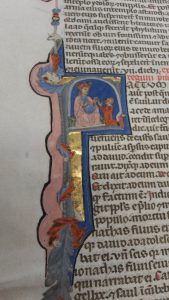Before coming to UGA, I was interested in possibly pursuing a library career, but I didn’t know that UGA had any classes that dealt with library issues. When my academic advisor recommended this class to me it sounded like something she’d made up – it was so specific yet so relevant to what I was wanting to study. I feel very fortunate to have had the opportunity to take this class, and highly recommend it to future students! It’s given us the chance to gain experience in practical things, such as how to handle rare books and manuscripts, and how to design a website and write a proposal for it.
It’s also been a great opportunity to look at some things from a cross-curricular standpoint. We’ve studied a little bit of history, art, communications, religion, and science all in one class. Of all those things, something that has really caught my interest is the lifetime of the manuscripts we’re studying and the ways the world has or hasn’t changed since then.

The medieval manuscripts that we’ve studied are usually between 800 and 500 years old, but as someone whose idea of “really old” is a hundred-year-old house, it can be difficult to wrap my mind around the concept of something being older than a few hundred years.
The paints that were used to decorate these manuscripts come from plants, insects, trees, or minerals that were obtained so long ago, it’s strange to think that we can go outside and find many of these same ingredients; they’re ancient yet still part of our modern world. Even the people who created manuscripts many generations before us had similar complaints as modern students. Amusingly relatable comments have been found in the margins of manuscripts that say things like:
“This page has not been written very slowly.”
“What I could not write by the beams of the sun I finished by candlelight.”
“Oh, my hand!”
And, more poignantly, “This is sad! O little book! A day will come in truth when someone over your page will say, ‘The hand that wrote it is no more.’” [4]. Maybe this is a reason why it feels odd to consider how old they are; nature and people’s attitudes have changed very little over the years despite massive advances in technology.
Meanwhile, so much of the scientific efforts of people throughout history have contributed to us being where we are today. Humanity’s base of scientific knowledge has progressed from basic chemical reactions in the medieval era to the point that we now understand how atoms and light waves work, such that some very intelligent people were able to build a device that can direct x-rays at a fragment and use a computer program to discover exactly which substances were used to create the pigments [1].
Walter Isaacson wrote in a 2014 lecture that it’s paramount that humanity finds a way to combine science and humanities going into the future, but at the same time “science couldn’t teach us anything worth knowing about the human mind” [2]. While it’s true that there are some things that just cannot be measured with data, it’s also true that science can help us understand a little bit better why some things are the way they are. Some examples that come to mind are the recent discovery of mathematic patterns in Beethoven’s music, as well as the Greek sculptor Polykleitos’ theories on the mathematics of aesthetic perfection in the 5th century BCE [3].
What I find interesting is that these analyses have come after the music or art was created, demonstrating that humans tend to create beautiful things instinctively, and we only realize that there are predictable patterns after the fact. With all that said, the technology that we’ve been able to utilize for this class has reflected that phenomenon in a way. The manuscripts were created long ago based on methods and inspirations that by today’s standards probably aren’t very scientific, and we’re just now beginning to be able to quantitatively study the materials and processes used to create them.
Overall I feel like this class, despite having such a specific scope, is very representative of the category of “humanities” and how often different fields of knowledge are intertwined. We’ve used so many different perspectives to learn about one particular area of study, and everyone in the class has had some sort of background knowledge that they were able to incorporate. It’s often said that we have to learn about the past in order to understand the present, and this class seems to accomplish that very well by comparing and contrasting modern society with the society revealed in the manuscripts, and it’s been a fascinating way of putting many modern customs into context.
by Taylor Lee
Citations:
[1] Popova, Maria. “Oh, My Hand: Complaints Medieval Monks Scribbled in the Margins of Illuminated Manuscripts.” Brain Pickings, 21 Mar. 2012, www.brainpickings.org/2012/03/21/monk-complaints-manuscripts/.
[2] Doing pXRF Right: An intermediate course for Archaeologists Course Workbook, by Alice M. W. Hunt & Robert J. Speakman (EMMA handout)
[3] Isaacson, Walter. “Walter Isaacson Lecture.” National Endowment for the Humanities, NEH.gov, www.neh.gov/about/awards/jefferson-lecture/walter-isaacson-lecture.
[4] Stokstad, Marilyn, and Michael W. Cothren. Art history, Volume 1. 5th ed., Pearson, 2013.